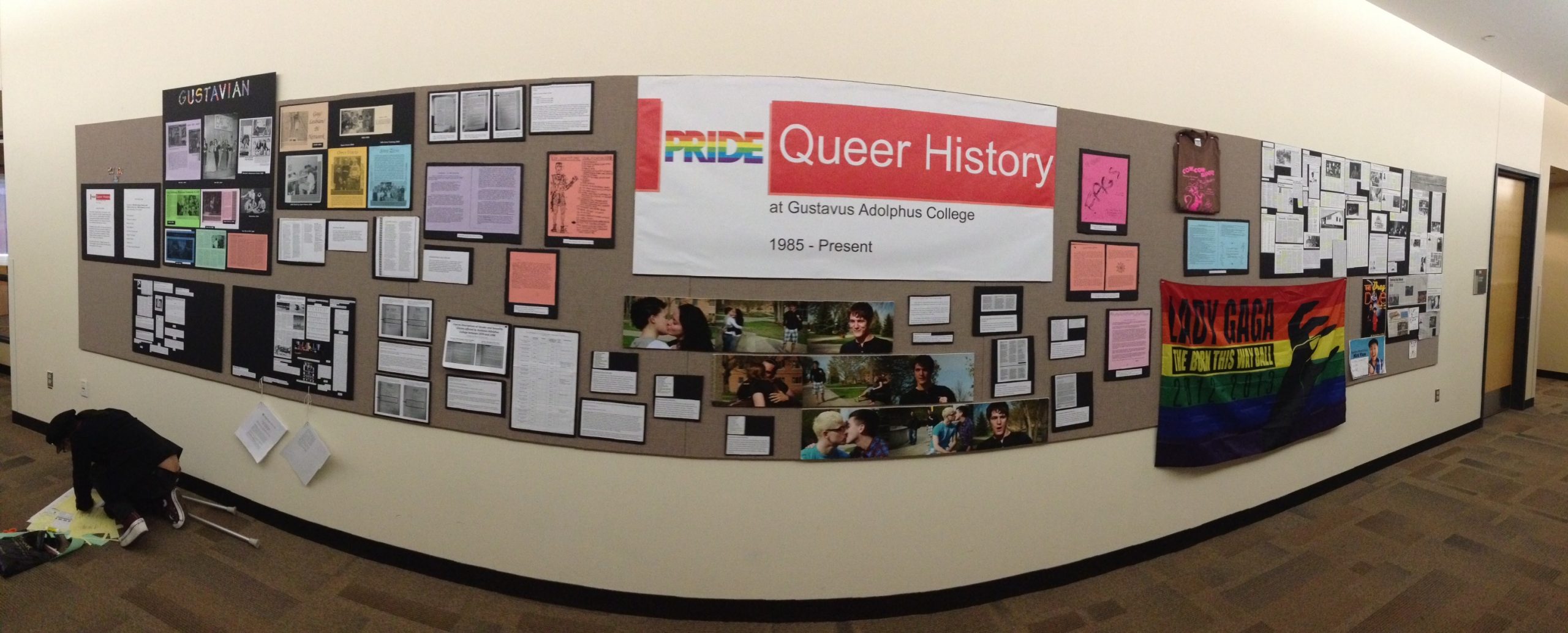 If you’ve had the time to walk by the bulletin outside the Caf, you may have seen a bright exhibit of all things gay and happy. History and Gender, Women, and Sexuality Professor Kate Wittenstein’s Queer History and Culture class has put together an exhibit of all things queer and LGBTQA related at Gustavus over its lengthy history as a college.
If you’ve had the time to walk by the bulletin outside the Caf, you may have seen a bright exhibit of all things gay and happy. History and Gender, Women, and Sexuality Professor Kate Wittenstein’s Queer History and Culture class has put together an exhibit of all things queer and LGBTQA related at Gustavus over its lengthy history as a college.
With earliest findings being from the 1950s, this was, as Professor Wittenstein put it, “our chance to archive and exhibit a history that is often overlooked or forgotten at Gustavus.” Though it is a history people would not immediately think of or possibly believe exists, Gustavus has had a queer community that has left an impressive mark upon its history as a college.
Students Erik Anderson, Hoang Anh Astrom, Avery Maijala, Caroline Pokrzywinski, Micah Thornquist, Mariah Welsh,Tianan Zhu and myself were instructed by Professor Wittenstein to research and select documents or objects concerning the queer history of the college. We were assigned separately to research from sources such as the Academic Curriculum and Catalogs, Gustie Guides, Ovanlig Newsletter, yearbooks, Heterodoxy, Counseling Center records, Chaplains Office, The Gustavian Weekly, Womyn’s Awareness Center, Queers & Allies and more.
We’ve all spent countless hours not only pouring over decades of documents, but also many hours selecting and preparing the highlights of our research for the Queer History Exhibit we set up on May 5.
It has been a lengthy process in which we are proud to have contributed to archiving a history at Gustavus that, though obscure, should be valued as equally as any other particular sort of history of this century and a half old college.
Thanks must be given to Jeff Jenson, archivist at the Folke Bernadotte Library for his help in allowing us access to the library’s archives and his assistance in setting up our exhibit.
Thanks must also be given to the Gender, Women, and Sexuality Department, as well as the History Department for their financial contribution toward the exhibit, and their support of our project. Finally, I must thank my Professor Kate Wittenstein herself for her guidance and advice concerning our research and preparation of the Queer History exhibit, and my fellow students who worked hard to preserve the past of Gustavus.
It has not only been a rewarding and proud experience to have been a part of; it’s been fun. Some may consider this a political or provocative statement to have made an exhibit focusing on the queer activities at Gustavus Adolphus College. Ultimately, our purpose was, first and foremost, to present a history often overlooked or sought to be hidden from the public eye. As with any other minority or form of history at Gustavus, the past of queer individuals at this college does exist, and Gustavus as we know it would cease to exist were it not for them. True, the overwhelming amount of our documents portray queerness or gayness in a positive or supportive manner, though it can be argued that is due to the overwhelming voice of those at this college being in support of LGBTQA individuals and recognition of their existence. It has been the historians’ choice to be in support of it, therefore our available data and documents present queerness in a relatively positive light. History is history, and it must be remembered and recognized lest it be lost or forgotten with the passage of time.
Whatever your stance on the queer lifestyle or queer history of the college, I invite you to look at the exhibit which shall be up for two weeks and then preserved in the archives of the college. It is not only a history of the queer individuals here or the queer history of the college; it is a history of you. It is a part of your experience and life while you grow and learn as a Gustavus Adolphus College student. As a wise man once said, “the past is the cause of the present, and the present shall be the cause of the future.”

Dear Mason,
Please read your 2nd-to-last paragraph over again. You are celebrating propaganda, not history. There’s a difference. College can be a great opportunity to think outside the box, even the queer box, and question the propaganda. For instance, did you notice your column makes not one mention of God or Jesus Christ? As you investigated the Queer PhRiOsPtAoGrAyNDA Exhibit, did you notice whether it makes any mention of God or Jesus Christ? Wouldn’t that be important at a Lutheran college? Inquiring minds want to know…
Dear John,
The purpose and intent of the class’ research was to find, collect, exhibit and archive LGBTQA related materials and artifacts from around the college. I cannot speak for my fellow classmates who researched other material, but I can assert my stance having looked through over a centuries worth of school newspapers.
I found many articles that mentioned queer related topics from political, personal, satirical and collegiate perspectives. Religion was tied in on a fair share of occasions, but there could have been an exhibit unto itself of just the Gustavian Weekly articles which pertained to queer related issues or material. This exhibit was intended to archive hidden history and promote healthy, open minded discussion. No one desired to make a political or religious motive in it.
As a Lutheran, I saw no purpose in imposing my own religious views into the article. My article was written with the intention to be objective as a historiographical analysis; an analysis of the class’ research presented as it was. My fellow classmates decided what to exhibit, I decided my part. As a columnist, I wrote the OPINION piece as the opinion of the class. The overlaying opinion was that we were showcasing history, preserving it, and not doing this as propaganda to coerce others into our manner of thinking. We certainly welcome discussion and questions, so I hope I’ve appropriately answered your inquiry.